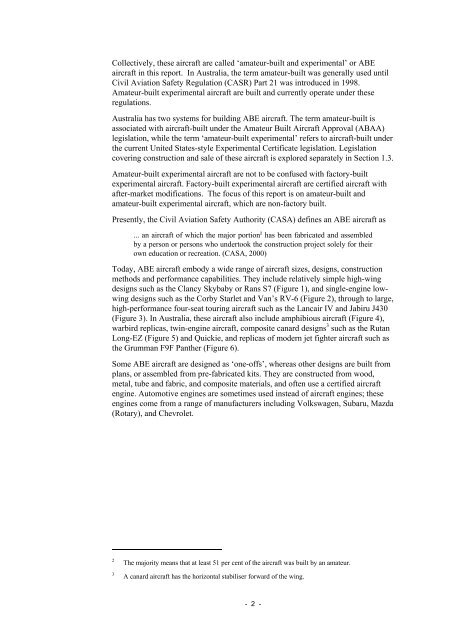Amateur-built and experimental aircraft - Australian Transport Safety ...
Amateur-built and experimental aircraft - Australian Transport Safety ...
Amateur-built and experimental aircraft - Australian Transport Safety ...
You also want an ePaper? Increase the reach of your titles
YUMPU automatically turns print PDFs into web optimized ePapers that Google loves.
Collectively, these <strong>aircraft</strong> are called ‘amateur-<strong>built</strong> <strong>and</strong> <strong>experimental</strong>’ or ABE<br />
<strong>aircraft</strong> in this report. In Australia, the term amateur-<strong>built</strong> was generally used until<br />
Civil Aviation <strong>Safety</strong> Regulation (CASR) Part 21 was introduced in 1998.<br />
<strong>Amateur</strong>-<strong>built</strong> <strong>experimental</strong> <strong>aircraft</strong> are <strong>built</strong> <strong>and</strong> currently operate under these<br />
regulations.<br />
Australia has two systems for building ABE <strong>aircraft</strong>. The term amateur-<strong>built</strong> is<br />
associated with <strong>aircraft</strong>-<strong>built</strong> under the <strong>Amateur</strong> Built Aircraft Approval (ABAA)<br />
legislation, while the term ‘amateur-<strong>built</strong> <strong>experimental</strong>’ refers to <strong>aircraft</strong>-<strong>built</strong> under<br />
the current United States-style Experimental Certificate legislation. Legislation<br />
covering construction <strong>and</strong> sale of these <strong>aircraft</strong> is explored separately in Section 1.3.<br />
<strong>Amateur</strong>-<strong>built</strong> <strong>experimental</strong> <strong>aircraft</strong> are not to be confused with factory-<strong>built</strong><br />
<strong>experimental</strong> <strong>aircraft</strong>. Factory-<strong>built</strong> <strong>experimental</strong> <strong>aircraft</strong> are certified <strong>aircraft</strong> with<br />
after-market modifications. The focus of this report is on amateur-<strong>built</strong> <strong>and</strong><br />
amateur-<strong>built</strong> <strong>experimental</strong> <strong>aircraft</strong>, which are non-factory <strong>built</strong>.<br />
Presently, the Civil Aviation <strong>Safety</strong> Authority (CASA) defines an ABE <strong>aircraft</strong> as<br />
... an <strong>aircraft</strong> of which the major portion 2 has been fabricated <strong>and</strong> assembled<br />
by a person or persons who undertook the construction project solely for their<br />
own education or recreation. (CASA, 2000)<br />
Today, ABE <strong>aircraft</strong> embody a wide range of <strong>aircraft</strong> sizes, designs, construction<br />
methods <strong>and</strong> performance capabilities. They include relatively simple high-wing<br />
designs such as the Clancy Skybaby or Rans S7 (Figure 1), <strong>and</strong> single-engine lowwing<br />
designs such as the Corby Starlet <strong>and</strong> Van’s RV-6 (Figure 2), through to large,<br />
high-performance four-seat touring <strong>aircraft</strong> such as the Lancair IV <strong>and</strong> Jabiru J430<br />
(Figure 3). In Australia, these <strong>aircraft</strong> also include amphibious <strong>aircraft</strong> (Figure 4),<br />
warbird replicas, twin-engine <strong>aircraft</strong>, composite canard designs 3 such as the Rutan<br />
Long-EZ (Figure 5) <strong>and</strong> Quickie, <strong>and</strong> replicas of modern jet fighter <strong>aircraft</strong> such as<br />
the Grumman F9F Panther (Figure 6).<br />
Some ABE <strong>aircraft</strong> are designed as ‘one-offs’, whereas other designs are <strong>built</strong> from<br />
plans, or assembled from pre-fabricated kits. They are constructed from wood,<br />
metal, tube <strong>and</strong> fabric, <strong>and</strong> composite materials, <strong>and</strong> often use a certified <strong>aircraft</strong><br />
engine. Automotive engines are sometimes used instead of <strong>aircraft</strong> engines; these<br />
engines come from a range of manufacturers including Volkswagen, Subaru, Mazda<br />
(Rotary), <strong>and</strong> Chevrolet.<br />
2 The majority means that at least 51 per cent of the <strong>aircraft</strong> was <strong>built</strong> by an amateur.<br />
3 A canard <strong>aircraft</strong> has the horizontal stabiliser forward of the wing.<br />
- 2 -

















